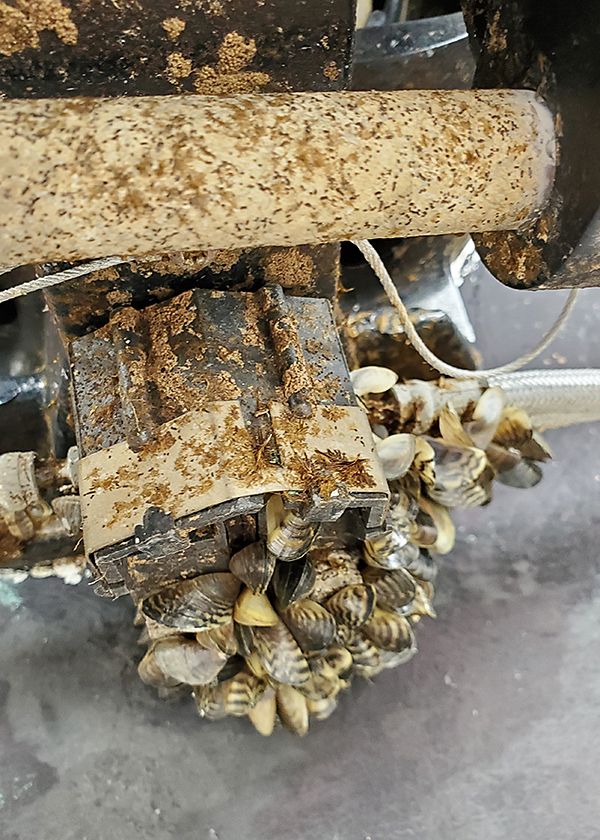
The North Dakota Game and Fish Department has confirmed the presence of invasive zebra mussels in Twin Lakes, LaMoure County, after a local cabin owner reported adult mussels attached to a floating log over the weekend.
Aquatic nuisance species coordinator Ben Holen said subsequent follow-up sampling found a few other zebra mussels attached to woody debris. In addition, Game and Fish Department ANS staff processed plankton tow net samples collected from Twin Lakes June 22, and zebra mussel veligers were detected in those samples indicating a breeding population of mussels within the lake.
The 1,735-acre lake is a popular fishing destination located a few miles north of LaMoure. Twin Lakes is located approximately six miles from Lake LaMoure, which had a confirmed finding of zebra mussels in 2020.
Moving forward, Holen reminds lake visitors that everyone plays a key role in stemming the spread of mussels to lakes that are not infested.
“This situation is yet another example of the importance for all water enthusiasts including boaters, anglers and skiers, to be aware of aquatic nuisance species and to take all precautions to prevent their spread,” Holen said.
Prevention is the best way to avoid spreading ANS. They often travel by “hitchhiking” with unsuspecting lake-goers.
“Always clean, drain and dry boats and other equipment before using another lake,” Holen mentioned. “Also, don’t transfer lake water or live fish to another body of water. This can help stop the spread of not only zebra mussels, but most aquatic nuisance species that may be present.”
Twin Lakes is now considered a Class I ANS Infested water, joining Lake LaMoure, Lake Ashtabula, the lower portion of the Sheyenne River, and the Red River in this designation. Emergency rules will go into effect immediately to prohibit the movement of water away from the lake, including water for transferring bait. Notices will be posted at lake access sites. For the remainder of this summer, ANS watercraft inspections will be increased at Twin Lakes.
Zebra mussels are just one of the non-native aquatic species that threaten our waters and native wildlife. After using any body of water, people must remember to follow North Dakota regulations:
- Remove aquatic vegetation before leaving the water access and do not import into North Dakota.
- Drain all water before leaving the water access.
- Remove drain plugs and devices that hold back water and leave open and out during transport.
- Do not import bait. For Class I ANS Infested waters, bait cannot be transported in water. In all other areas, bait must be transported in a container that holds 5 gallons or less. Remember that it is illegal to dump unused bait on shore or into the lake.
In addition to North Dakota regulations, the Game and Fish Department strongly recommends:
- Avoid mooring watercraft in zebra mussel infested waters.
- Clean – remove plants, animals and excessive mud prior to leaving a water access.
- Drain – drain all water prior to leaving a water access.
- Dry – allow equipment to dry completely before using again or disinfect. This includes boat docks and boat lifts brought from other waters/states. A 7-day dry time is recommended after recreating on a zebra mussel infested water at typical summer temperatures.
For more information about ANS in North Dakota, options for disinfection, or to report a possible ANS, visit https://gf.nd.gov/ans.
ABOUT ZEBRA MUSSELS
Zebra mussels are dime-sized mollusks with striped, sharp-edged, two-part shells. They can produce huge populations in a short time and do not require a host fish to reproduce. A large female zebra mussel can produce 1 million eggs, and then fertilized eggs develop into microscopic veligers that are invisible to the naked eye. Veligers drift in the water for at least two weeks before they settle out as young mussels which quickly grow to adult size and reproduce within a few months.
After settling, zebra mussels develop byssal threads that attach their shells to submerged hard surfaces such as rocks, piers, and flooded timber. They also attach to pipes, water intake structures, boat hulls, propellers, and submerged parts of outboard motors. As populations increase, they can clog intake pipes and prevent water treatment and electrical generating plants from drawing water. Removing large numbers of zebra mussels to ensure adequate water flow can be labor-intensive and costly.
Zebra mussels are native to the Black and Caspian seas of western Asia and eastern Europe and were spread around the world in the ballast water of cargo ships. They were discovered in Lake St. Clair and the Detroit River in 1988 and quickly spread throughout the Great Lakes and other rivers including the Mississippi, Illinois, Ohio, Tennessee, Arkansas and Hudson. They were first discovered in North Dakota in 2015 in the Red River. Moving water in boats has been identified as a likely vector, as has importing used boat lifts and docks.
